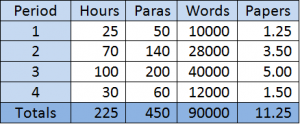I’m not an ethnographer by any stretch, but I have worked closely with many authors who use ethnographic description in their organisational analyses. On that basis (and you can take it for what it’s worth) I have some advice. It’s something I find myself saying quite often, so I thought I may as well write it down too.
Ethnography covers a wide range of specific methods, but let’s confine ourselves to participant observation and interviews. These are ways of collecting data, which will consist of descriptions (in field notes) of what people did in practice, and transcriptions (often of recordings) of what they said in interviews. The methods section of the paper will describe how the data was collected, i.e., how the observations were arranged and the interviews conducted, as well as how they were recorded, transcribed and coded.
Now, the ethnographer–the “people writer”, if you will–has the task of presenting this data in the analysis. Many researchers, I have found, construe their data as a text that needs to be somehow processed into publishable prose. They select passages of their notes or transcripts, paste them into a document, and connect them together by writing their own prose. But it is also, for many people, a torturous process, comparable to weeding a magically growing garden that is constantly changing form, blooming and wilting from day to day, as progress and mood dictate. It’s sometimes exciting, but not always pleasant work.
So I usually suggest a different approach. It begins by getting away from thinking of the analysis as primarily a presentation of your data and construing it instead as an attempt to represent the people you have studied. You have observed them doing something, but your analysis will tell us why they did it. They have said something in the interviews, but your analysis will tell us what they meant. You are analyzing the meaning of their practices, not merely telling us what happened.
Instead of beginning with juicy quotes or gripping anecdotes, begin with the claims that your analysis allows you to make about the people you have studied. Tell us what you know about these people, not just what they’ve told you or what you’ve seen them do. Think of claims like the following:
- The managers at XYZ Corp are aloof and distant.
- The local employees perceive their foreign managers as arrogant and out of touch.
- The community places a high premium on quality workmanship.
- The board is frustrated with the inefficiency of the IT department.
- The team leader is taciturn and often dismissive.
- The team members hold their leader in very high esteem.
- There is a great deal of anxiety about the transition.
- The employees are ambivalent about the new strategy.
I could go on. The point is that none of these are statements of direct observation, but we can imagine a paragraph that presents evidence to support each of them. And that evidence will consist of statements of direct observation, drawn from the data. Instead of giving yourself the the task of “presenting the data”, give yourself the task of supporting claims on the basis of your data. That should make it much easier to decide the day before what you are going to say. And that will hopefully make the writing more enjoyable.
